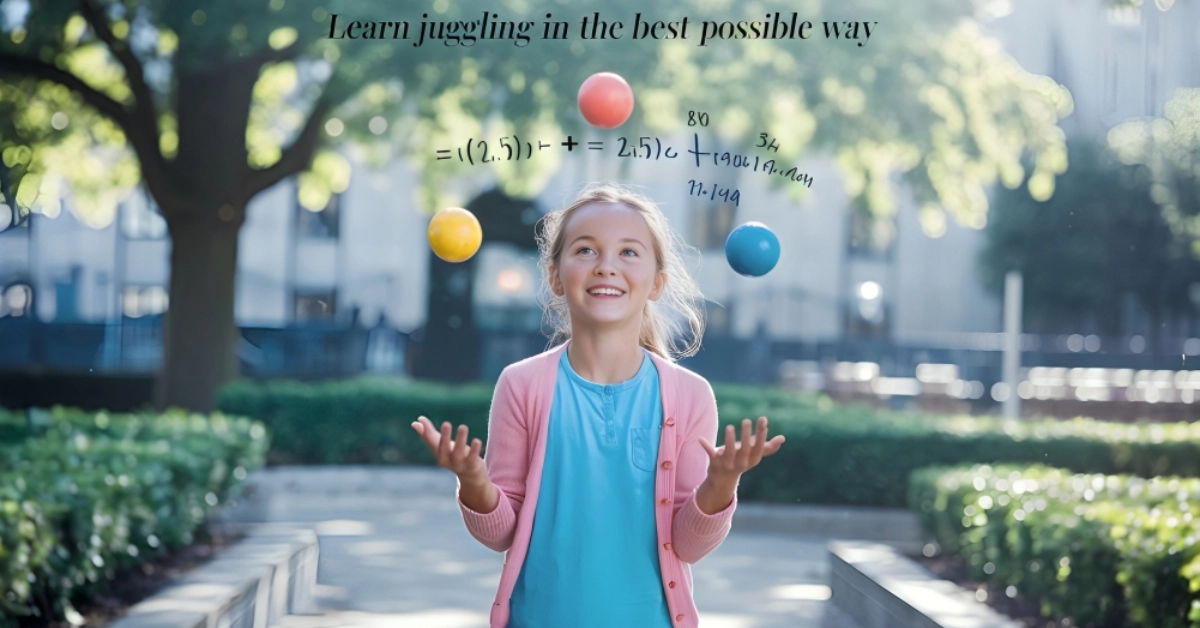Complete Guide to Learning 3-Ball Juggling
Welcome to your comprehensive guide to mastering the art of 3-ball juggling! Having mastered the skill at age 15, I can tell you that juggling isn’t just about keeping balls in the air—it’s about developing focus, coordination, and persistence.
This how to learn to Juggle guide combines proven techniques with practical insights to help you progress from a complete beginner to a confident performer.
Quick Facts About Juggling:
- 🧠 Improves brain connectivity and spatial awareness
- 💪 Enhances hand-eye coordination by up to 25%
- 🎯 Increases focus and concentration
- 😌 Reduces stress and anxiety
- 🏃 Burns approximately 280 calories per hour
Basic Equipment and Setup
Equipment Needs
- 3 juggling balls of identical size and weight
- Optional: 1-2 spare balls
- Practice space: 6×6 feet minimum, good lighting
- Drop-friendly surface: carpet or outdoor grass is recommended
Ideal Balls for Beginners
| Type | Pros | Cons | Recommended Size |
|---|---|---|---|
| Bean Bags | – Non-roll, easy to catch – Durable – Good weight | – Can be expensive – May leak if damaged | 2.5-2.75 inches |
| Tennis Balls | – Readily available – Bouncy – Inexpensive | – Roll when dropped – Light weight | 2.6 inches |
| Stage Balls | – Perfect weight – Professional feel – Durable | – Expensive – Roll when dropped | 2.75-3 inches |
Proper Stance
Key Points:
- Stand with feet shoulder-width apart
- Keep elbows close to body
- Maintain upright posture
- Focus eyes at throw peak point
- Keep shoulders relaxed
Eyes focused at peak
↑
o | o
/ \|/ \
/ o \
/ | \
/ | \
Elbows In → [Body] ← Elbows In
\ | /
\ | /
\ | /
\ | /
\ | /
\ | /
[Feet]
Shoulder-width apartFundamental Techniques
One-Ball Practice (15-30 minutes daily)
Basic Throw
- Basic Throw
- Height: Eye level + 12 inches
- Arc: Parabolic curve
- Landing: Same hand position as throw
Cross-Body Throw
Starting Position → Peak Height (6-8 inches above eye level)
R ↗ ↘ L
→ / \ ←
/ / \ \
/ / \ \
/ / \ \
RH / \ LHOptimal Throw Heights
| Pattern Type | Recommended Height | Time in Air |
|---|---|---|
| Basic Cascade | Eye level + 12″ | 0.5 seconds |
| Learning Pattern | Eye level + 18″ | 0.75 seconds |
| Performance | Eye level + 8″ | 0.4 seconds |
Start with one ball. Practice throwing from one hand to the other, maintaining a consistent arc height of about eye level. Aim for:
- 50 successful catches in a row
- Consistent arc height Smooth
- controlled movements
Two-Ball Progression
Two-Ball Exchange Pattern
Phase 1: Starting Position
R• •L
\ /
\/
Body
Phase 2: First Throw
R •L
\ /
\/
Body
•↗
Phase 3: Second Throw
R L
\ /
\/
Body
•↗ •↗The two-ball exchange is where most beginners make crucial progress. Here’s your practice routine:
Practice Sequence:
- Hold two balls in dominant hand
- Throw ball 1 in an arc
- As ball 1 peaks, throw ball 2
- Catch ball 1 with empty hand
- Catch ball 2 with starting hand
Target: 20 successful exchanges without drops
Common Two-Ball Drills
Continuous Exchange
- 20 successful exchanges minimum
- Focus on rhythm and height consistency
Height Calibration
Target Zone
-----------
↑ • •
| / \ / \
| / X \
|/ / \ \
RH / \ LHThree-Ball Cascade
Basic Cascade Pattern
Basic Cascade Pattern Flow
Learning Milestones
| Stage | Goal | Success Criteria |
|---|---|---|
| Beginner | 3 catches | Clean throws, proper height |
| Intermediate | 10 catches | Consistent rhythm |
| Advanced | 30+ catches | Smooth pattern flow |
Juggling Learning Path
Stage 1: Foundation
Stage 2: Two Ball Skills
Stage 3: Full Pattern
Stage 4: Advanced
Troubleshooting Common Issues
Forward Movement Correction
Problem: Balls moving forward
Solution:
Incorrect Throw Path Correct Throw Path
↗ → ↗ ↓
/ /
/ /
/ /
RH RHPattern Consistency
Key Checkpoints:
- Elbow position
- Throw height
- Catch position
- Rhythm timing
Practice Methods
Recommended Practice Schedule
Practice Session Flow
Wall Practice Setup
Wall Exercise Position:
Wall
|
| 12-18" from wall
|
|
YouAdvanced Techniques
Reverse Cascade Pattern
Standard vs Reverse
↗ ↖ ↖ ↗
/ \ / \
/ \ / \
RH LH RH LHCommon Three-Ball Tricks
- Mills Mess
- Shower Pattern
- Box Pattern
- Half-Shower
Advanced Three-Ball Juggling Tricks
1. Mills Mess Pattern
The Mills Mess is one of the most impressive-looking three-ball patterns, characterized by crossed arms and a weaving motion.
Pattern Breakdown
| Phase | Arm Position | Ball Movement | Key Point |
|---|---|---|---|
| 1 | Right over Left | Cross throw from Right | Keep elbows loose |
| 2 | Uncross | Center throw from Left | Maintain rhythm |
| 3 | Left over Right | Cross throw from Left | Mirror phase 1 |
| 4 | Uncross | Center throw from Right | Complete cycle |
Mills Mess Sequence:
Phase 1: Phase 2: Phase 3: Phase 4:
o o o o o o
\ o \ / \ o \ /
\ / o \ / o
[×] [ ] [×] [ ]
Arms Arms Arms Arms
Crossed Uncross Crossed UncrossLearning Steps
- Practice crossed-arm throws with one ball
- Add second ball for crossed-arm exchange
- Introduce third ball slowly
- Focus on rhythm before speed
2. Shower Pattern
The Shower is a classic pattern where balls follow a circular path, with high throws from one hand and quick passes from the other.
Pattern Structure
| Hand | Action | Height | Timing |
|---|---|---|---|
| Right | High throw | Eye level + 24″ | 1 second |
| Left | Quick pass | Waist level | 0.5 second |
| Right | Catch & throw | Eye level + 24″ | Immediate |
| Left | Quick pass | Waist level | 0.5 second |
Shower Pattern Flow:
↑ 3
| /
2→ | /
|/ 1
RH → LH
\___/Key Components
- High throws: Always from dominant hand
- Quick passes: Lower, horizontal movements
- Rhythm: “ONE-two-ONE-two”
3. Box Pattern
The Box Pattern creates a square shape with the ball trajectories, requiring precise throws and catches at four distinct points.
Box Configuration
A ----→ B
↑ |
| |
| ↓
D ←---- C
Corner Points:
A: Upper Left
B: Upper Right
C: Lower Right
D: Lower Left| Corner | Action | Direction | Height |
|---|---|---|---|
| A | Throw | Horizontal | Eye level |
| B | Catch & Throw | Vertical down | Dropping |
| C | Throw | Horizontal | Waist level |
| D | Catch & Throw | Vertical up | Rising |
Practice Sequence
- Practice horizontal throws (A→B, C→D)
- Master vertical drops (B→C)
- Perfect vertical rises (D→A)
- Combine all movements
4. Half-Shower
The Half-Shower combines elements of the cascade and shower patterns, creating an asymmetrical but flowing pattern.
Pattern Elements
| Element | Description | Height | Direction |
|---|---|---|---|
| High Throws | From dominant hand | Eye level + 18″ | Diagonal |
| Low Throws | From non-dominant hand | Eye level | Straight across |
| Catches | Alternating hands | Various | Following throw arc |
Half-Shower Flow:
↗ ↘
/ \
RH → → LH
\ /
↖ ↙Mastery Points
Height Differentiation
- High throws: 1.5x cascade height
- Low throws: Standard cascade height
Rhythm Pattern
Count: 1-2-3-4
High: 1---3---
Low: -2---4--Common Elements Across All Tricks
Speed and Control Matrix
| Trick | Starting Speed | Control Difficulty | Practice Priority |
|---|---|---|---|
| Mills Mess | Slow | High | Pattern memorization |
| Shower | Medium | Medium | Rhythm stability |
| Box | Very Slow | High | Spatial accuracy |
| Half-Shower | Medium-Slow | Medium-Low | Height control |
Learning Progression
Practice Tips for All Tricks
Start Slow
- Begin at 50% normal speed
- Focus on form over speed
- Increase tempo gradually
Pattern Isolation
Break each trick into phases:
Phase 1: Single ball practice
Phase 2: Two-ball elements
Phase 3: Complete pattern slow
Phase 4: Speed developmentCommon Mistakes Prevention Error Cause Correction Pattern collapse Rushed throws Slow down, focus on form Lost rhythm Inconsistent timing Practice with metronome Poor height control Lack of focus point Use wall markings Pattern drift Improper throw angles Check shoulder alignment.
Success Indicators
- Clean catches
- Consistent rhythm
- Pattern stability
- Smooth transitions
Remember: Each trick builds upon basic juggling skills. Don’t rush to learn all tricks at once. Master one before moving to the next, and always maintain good form over speed.
Performance Development
Focus Techniques
- Rhythm counting
- Pattern visualization
- Breath control
- Spatial awareness
Recovery Methods
Quick Save
Drop → Immediate throw of remaining ball
Continue pattern with two balls
Seamlessly reintroduce third ballLearning Timeline and Milestones
Learning Progression Flow
Expected Progress Timeline
| Week | Achievement | Practice Hours |
|---|---|---|
| 1 | One-ball mastery | 3-4 |
| 2 | Two-ball exchanges | 4-5 |
| 3-4 | Basic cascade attempts | 8-10 |
| 5-6 | Consistent cascade | 10-12 |
| 7-8 | Extended patterns | 12-15 |
Performance Readiness Checklist
- [ ] 50+ catches consistently
- [ ] Smooth pattern flow
- [ ] Comfortable with basic variations
- [ ] Can recover from drops
- [ ] Maintains rhythm under pressure
Remember: Progress varies by individual. Focus on quality practice rather than rushing through milestones. Regular, deliberate practice sessions of 20-30 minutes are more effective than occasional long sessions.
Additional Resources and Tips
Mental Practice Visualization
- Imagine perfect throws
- Visualize ball trajectories
- Practice hand movements without balls
- Count rhythm patterns mentally
Practice Environment Setup
- Good lighting
- Minimal distractions
- Non-slippery surface
- Adequate ceiling height (8+ feet)
- Mirror if available
Juggling Practice Timer
Use the embedded timer below to track your practice sessions. Start with 2 or 5-minute intervals and gradually increase as you progress.
Practice Timer
Remember: juggling is a journey, not a destination. Every drop is a learning opportunity, and every catch brings you closer to mastery. Stay patient, practice regularly, and most importantly, enjoy the process!
Quick Reference Stats:
- Average time to learn basic cascade: 2-4 weeks
- Success rate with proper technique: 95%
- Typical practice sessions needed: 20-30
- Most common breakthrough point: Day 5-7

